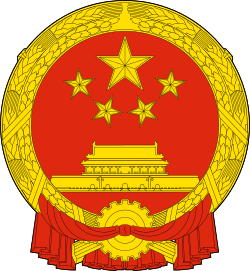Supreme People's Court
| Supreme People's Court of the People's Republic of China 中华人民共和国最高人民法院 Zhōnghuá Rénmín Gònghéguó Zuìgāo Rénmín Fǎyuàn | |
|---|---|
|
Emblem of the People's Court of the People's Republic of China | |
| Established | September 1954 |
| Country | People's Republic of China |
| Location | Beijing |
| Composition method | Presidential selection with National People's Congress approval |
| Authorized by | Constitution of the People's Republic of China |
| Judge term length | 5 years |
| Website | http://www.court.gov.cn/ |
| President and Chief Justice | |
| Currently | Zhou Qiang |
| Since | 15 March 2013 |
| Executive Vice President | |
| Currently | Shen Deyong |
| Since | March 2008 |
 |
| This article is part of a series on the politics and government of China |
|
|

The Supreme People's Court (Chinese: 最高人民法院; pinyin: Zuìgāo Rénmín Fǎyuàn) is the highest court in the mainland area of the People's Republic of China. Hong Kong and Macau, as special administrative regions, have their own separate judicial systems based on British common law traditions and Portuguese civil-law traditions respectively, and are out of the jurisdiction of the Supreme People's Court.
The court includes over 340 judges which meet in smaller tribunals to decide cases.
Since March 2013, the President of the Supreme People's Court and Chief Grand Justice has been Zhou Qiang.
The SPC trial process consists of a four level, two-hearing system.
History
Procedure
In 2005, the Supreme People's Court announced its intent to "[take] back authority for death penalty approval" over concerns about “sentencing quality”,[1] and the National People's Congress officially changed the Organic Law on the People's Courts requiring all death sentences to be approved by the Supreme People's Court on 31 October 2006.[2] It has been reported that since the new review process, the court has rejected 15 percent of the death sentences decided by lower courts.[3]
Organisational Structure
Courts of the SPC:
Departments within the SPC:
- research office
- general affairs office
- personnel department
- judicial affairs department
- administrative affairs department
- office affairs bureau
- foreign affairs bureau
- education department
Circuit courts:
- First Circuit (established in Shenzhen, Dec 2014)[4]
- Second Circuit (established in Shenyang, Dec 2014)[5]
Presidents and Vice Presidents of the Court
- 1949 - 1954: Supreme People's Court of the Central People's Government
- President: Shen Junru
- 1954 - 1959: Supreme People's Court of the People's Republic of China under the 1st National People's Congress
- 1959 - 1965: 2nd National People's Congress
- President: Xie Juezai
- Vice Presidents: Wu Defeng, Wang Weigang, Zhang Zhirang
- 1965 - 1975: 3rd National People's Congress
- President: Yang Xiufeng
- Vice Presidents: Tan Guansan, Wang Weigang, Zeng Hanzhou, He Lanjie, Xing Yimin, Wang Demao, Zhang Zhirang
- 1975 - 1978: 4th National People's Congress
- President: Jiang Hua
- Vice Presidents: Wang Weigang, Zeng Hanzhou, He Lanjie, Zheng Shaowen
- 1978 - 1983: 5th National People's Congress
- President: Jiang Hua
- Vice Presidents: Zeng Hanzhou, He Lanjie, Zheng Shaowen, Song Guang, Wang Huaian, Wang Zhanping
- 1983 - 1988: 6th National People's Congress
- President: Zheng Tianxiang
- Vice Presidents: Ren Jianxin, Song Guang, Wang Huaian, Wang Zhanping, Lin Huai, Zhu Mingshan, Ma Yuan
- 1988 - 1993: 7th National People's Congress
- President: Ren Jianxin
- Vice Presidents: Hua Liankui, Lin Huai, Zhu Mingshan, Ma Yuan, Duan Muzheng
- 1993 - 1998: 8th National People's Congress
- President: Ren Jianxin
- Vice Presidents: Zhu Mingshan, Xie Anshan, Gao Changli, Tang Dehua, Liu Jiachen, Luo Haocai, Li Guoguang, Lin Huai, Hua Liankui, Duan Muzheng, Wang Jingrong, Ma Yuan
- 1998 - 2003: 9th National People's Congress
- President: Xiao Yang
- Vice Presidents: Zhu Mingshan, Li Guoguang, Jiang Xingchang, Shen Deyong, Wan Exiang, Cao Jianming, Zhang Jun, Huang Songyou, Jiang Bixin
- 2003 - 2007: 10th National People's Congress
- President: Xiao Yang
- Vice Presidents: Cao Jianming, Jiang Xingchang, Shen Deyong, Wan Exiang, Huang Songyou, Su Zelin, Xi Xiaoming, Zhang Jun, Xiong Xuanguo
- 2008 - 2013: 11th National People's Congress
- President: Wang Shengjun
- Vice Presidents: Shen Deyong (Executive), Zhang Jun, Wan Exiang, Jiang Bixin, Su Zelin, Xi Xiaoming, Nan Ying, Jing Hanchao, Huang Ermei
- 2013 - present: 12th National People's Congress
- President: Zhou Qiang
See also
- Court system of the People's Republic of China
- Supreme People's Procuratorate - the highest legal supervisory body, charged with safeguarding the laws and people's rights.
- Three Supremes
References
- ↑ Dickie, Mure (2005-10-27). "China's top court to review all death sentences". Financial Times.
- ↑ "China changes law to limit death sentence". China Daily. 2006-10-31.
- ↑ Bodeen, Christopher (2008-04-10). "China Hails Reform of Death Penalty". San Francisco Chronicle.
- ↑ First Circuit Court of the Supreme People's Court established
- ↑ Second Circuit established
External links
- The Supreme People's Court of the People's Republic of China Official site.
- Chinacourt English website sponsored by the Supreme People's Court, with court news and legal information including biographical information for the Grand Justices.
- PRC Laws Links to English versions of the Constitution, General Principles of Civil Law, Administrative Procedure Law, Civil and Criminal Procedure Laws, and the Judges Law.
- The Supreme People's Court Court information in English, maintained at People's Daily Online.
- The Supreme People's Court of the People's Republic of China English website.
Coordinates: 39°54′10.7″N 116°24′18.9″E / 39.902972°N 116.405250°E
